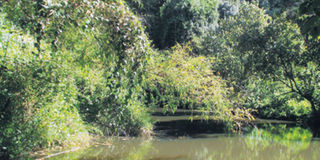A forest full of surprises: Exploring Eburru

The thought of spending a chilly day enveloped by the cold mist on the high slopes of Eburru makes me groan but it turns out to be a forest full of surprises. PHOTO/RUPI MANGAT
What you need to know:
- I long to see the elusive bongo – a rare antelope with ivory-tipped horns. Once it was a common feature in the high mountain forests, but as trees were cut down for timber and paper industries, depleting the bongo’s habitat, and as it fell prey to hunters, the beautiful antelope became a rare breed.
The thought of spending a chilly day enveloped by the cold mist on the high slopes of Eburru makes me groan, but I am eager to explore new territory.
I long to see the elusive bongo – a rare antelope with ivory-tipped horns. Once it was a common feature in the high mountain forests, but as trees were cut down for timber and paper industries, depleting the bongo’s habitat, and as it fell prey to hunters, the beautiful antelope became a rare breed.
There have been sporadic sightings on the Aberdares, and recently in Eburru, where there is a special bongo surveillance team.
We drive up to the forest on a road lined with wheat fields that replaced pyrethrum farms from the colonial era.
We also pass villagers collecting water from the public underground steam vent pipes.
Our first stop is at the Kenya Forest Service office to pick up the forest guard who will accompany us.
A lone Ogiek homestead stands close to a new 15 kilometre fence put up by Rhino Ark to protect the 87-kilometre forest and its inhabitants.
The Ogiek are hunter-gatherers who lived off the forests for centuries. A geo-thermal rig and station by the entrance caps the steam from the ancient volcano.
Entering a new forest is always exciting and being in the company of naturalists who know what they are talking about makes it all the more so.
I am with Jack Murage and Martin Kihuyu, the naturalists from the Great Rift Valley Lodge, and Dr Luca Borghesio, a forest scientist.
The car inches its way through the narrow forest road that is shouldered by towering trees.
RICH FLORA AND FAUNA
At some point we catch a glimpse of Lake Naivasha below. We stop to check out a glade of the forest which was once cleared, but is now regenerating.
Colobus monkeys screech like racing bikes while the quieter blue monkeys shy away.
A flash of the Hartlaub turaco’s red flanks adds vivid colour. The birders keep a look out for species of highland forests like the Orange thrush and the Brown-chested alethe as I watch the spaces.
But the elusive bongo is deeper in the forest on the other side of the mountain.
Ten kilometers away from the main gate we drive out of another forest gate, and past small farms. Soysambu Conservancy and Lake Elementaita come into sight and if we were to keep on the road we would get there.
We turn uphill again, past more homesteads and livestock and back into the fence line. The forest begins to thicken with towering podo, dombeya, Olea Africana and more than 40 other plant species.
An enormous tree blocks the road on the edge of a deep gorge. Mark slowly inches the car past the tree.
It is a precarious position – one wrong move would see us tumbling down and into the valley. Then a tire sinks into a hole. We are stuck!
THREATENED VILLAGERS
A group of villagers from Ole Sirwa come to our aid and not being of much help, I stroll up the hills surrounded by valleys.
A burst of orange breaks the green monotony and I spot a chameleon as colourful as its surroundings.
It’s the von Hoehnel’s chameleon named after the explorer who sighted Mathews Range in 1887 while accompanying Count Teleki to Lake Turkana.
Three hours later the car is out of the hole and we make for the dam where the bongo come to drink. It is an uphill 30-minute walk to the close-canopy forest. We could have seen the bongo but for time.
At Morop, by the fence at Ol Sirwa gate, Jane Nyamosi invites us for tea.
Part of her homestead is in the protected forest and she has to move out. Munching on freshly boiled maize cobs and sipping hot tea, she is optimistic that everything will pan out.
Back in the forest, the evening is a flurry of activity. Colobus monkeys leap on the high trees, their white mantels catching the setting sun’s rays. It is time for a little spa in the forest – a natural steam vent in the rocks to refresh us on the mountain.
Get active at The Great Rift Valley Lodge and Golf Resort
Two hours away from Nairobi, the lodge provides a perfect break to relax or get seriously active. I recommend the latter.
The 18-hole championship course at 7,000 feet on the Eburru Range offers serious golfers a challenge and is famous for one the longest holes in Kenya – the par 5 – 17th ‘signature’ at 598 metres (654 yards).
There’s more action to be enjoyed at the adjacent Lake Naivasha: swimming, tennis, horse-riding, hiking or boating on the lake, and of course birding and excursions to Eburru forest and more.
For youngsters there is free membership to the bush-savvy Adventurers’ club (for 3-11 year-olds) or Young Rangers club (for 12-17 year-olds.)
There’s a range of accommodation at GRLV from private chalets to villas and ensuite rooms.




